ARC30003
Ben MacLean
103612437
28th of May, 2023
Benjamin MacLean Credits:

ARC30003
Ben MacLean
103612437
28th of May, 2023
Benjamin MacLean Credits:
Hermes the messenger of the gods, was one of the 12 main gods of Greece. He served his father - Zeus - as to deliver all messages across the realm.
Depicted as cunning, fast and fluent, Hermes was the true depiction of a Greek God.

Hermes was depicted as a youthful, agile figure who wore winged sandals and carried a staff known as the caduceus. His duties included delivering messages and guiding the souls of the dead to the underworld. He was depicted as fast, a speed runner of the mythical world, being able to travel from Mount Olympus to the Underworld.

Hermes was the son of Zeus and the Pleiad Maia. He was considered one of Zeus’s favorite sons and was often given important tasks to complete, such as guiding Persephone to the underworld or helping Odysseus on his journey home. This story is the one I chose to follow and try and depict through my machine.
For this, the machine needed to have some fundamental understandings. What, why and how.
These images helped understand who and what Hermes was. As well as understand other people’s interpretation of him, including colour ways, text, character development and overall aesthetic design.
On top of that, I understood what direction to ask MidJourney (AI) to produce images that I wanted. When first using Midjourney, the images came out very cartoonish and unprofessional/alien like. This helped narrow down my ideas and exploration.
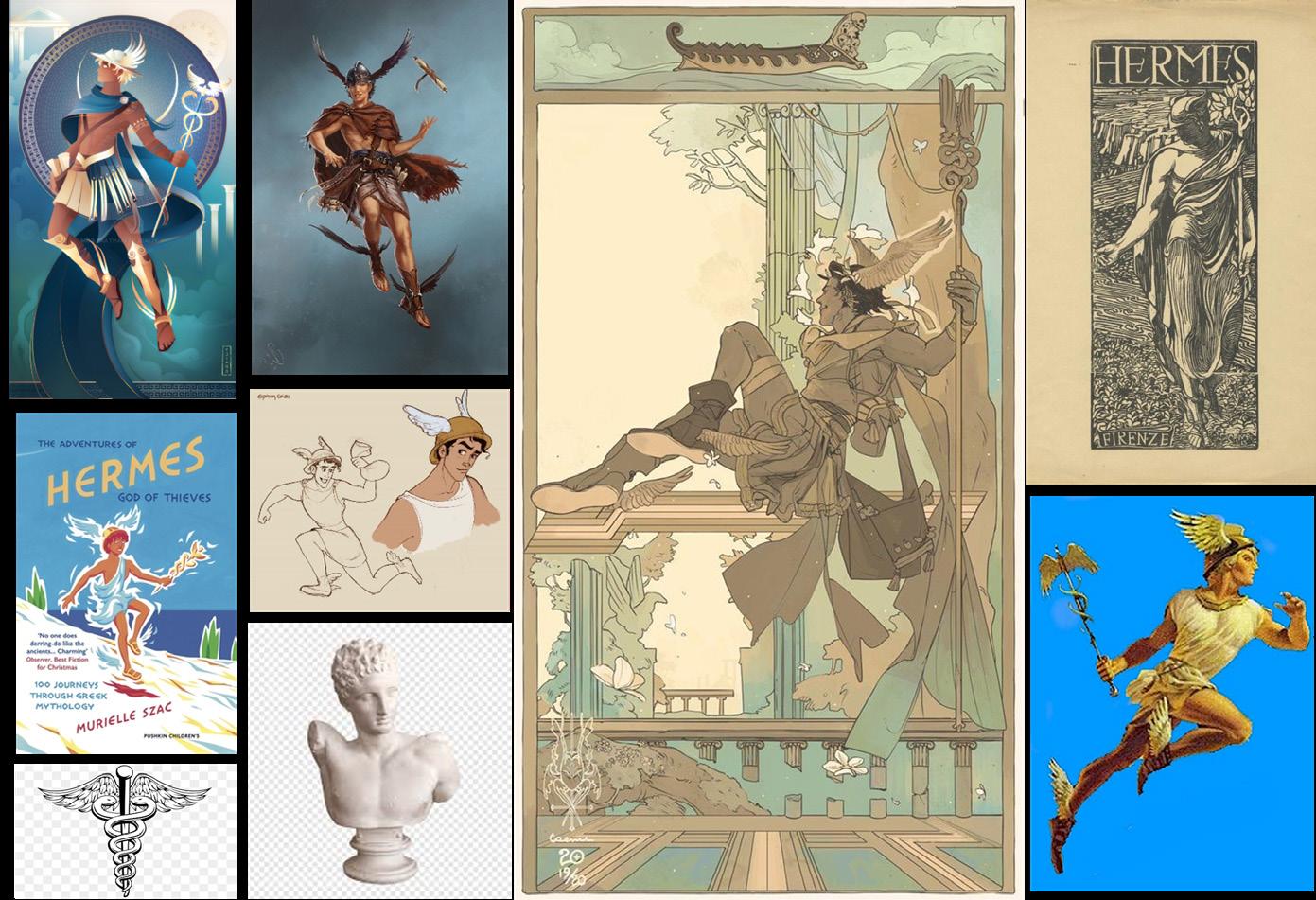
Asking MidJourney to produce images based off colours, textures and characters resulted in dynamic pictures generated by AI, somewhat like museum sculptures. I liked how this pictures turned out.

Similarly, I asked the AI to create different art style technique, like as seen on the right, with lino printing techniques. I gathered these images to make darker work, in terms of showing a different side of Hermes, a different complexity.

In contrast, sticking with the lighter line work like style, these images were producible. More of a 2D element, I furthered these ideas into antique poster styles, to grasp colours, and textures that I could incorporate into the final design poster.



Architecture should communicate a story as the art form of building is translucent, freely flowing and expressive. People interact with architecture as they live, work or breathe within the construction of buildings formed from architecture. Architecture is usually perceived as static, with solid and hard surfaces forming all within the characteristics of architecture. Constructions such as The Serpentine Gallery Pavilion, designed by SANAA, creates a flow throughout the space, creating meaning and movement, thus telling a story. This allows the designer to force people down routes and pathways to tell stories, and force them to participate in the exhibition. The Serpentine Gallery Pavilion moves and controls people unconsciously by the pure form and layout, transforming a static, built form, into a fluent story to communicate. Therefore, architecture needs to tell as story of progression and interaction.
AI will change the systematics of an architect, but will not replace the need to invest or contract an architect. An architect, by definition, is someone who can construct, alternate or redevelop spaces designed for humans to become more functional, ease access and be aesthetically pleasing. Artificial intelligence can recreate schematic and designs with a high level of detail to images and reports, but fails to connect on a human level. A client will still need to communicate those ideas of future designs for someone to develop and understand, and at the level that AI is at, this will not be replaceable. However, AI is aiding the abilities of an architect as to help with rendering images to clients, or by producing images and ideas. Furthermore, architect branches into alternative fields, like engineering, town planning, and manufacturing, which encompass certain constraints on the design, which can be difficult to interpret. Artificial Intelligence, although impressive and adaptable, will not ‘steal’ or make the role of an architect obsolete, but help aid the design processing creation.
AI will aid the design procedure and ‘workflow’ of an architects methodology. This means that AI can be more accessible and ease the access of how work can be done in a timely method. More tools and more work can be done and constructed with AI tools, like as imagery, texts, and ideas. Artificial Intelligence will benefit the first production of work, and create a starting point for the workflow to begin.
Able to convey an idea via line thicknesses

How does a 2D line drawing suggest an image of 3D object?
2D linework can suggest 3D imagery via line weights and controlling shading. Simple drawings can create depth by creating realistic shadowing and 3 dimensional shapes. And alternatively, the opposite. Line weights that are hatched, or dashed, create the interpretation of depth via retracting from the page/ 2 dimensional form.
How does an image, or images, of a 3D object suggest movement over time?
Line work can be repetitive, and with repetition, comes movement. Movement can be created with the elements of warping line work, which can produce a sense movement within a still. Furthermore, our brains can recognize previous imagery that we experience in our day-to-day lives, which can aid to interpret the movement occurring in a still image. For example, if the two- dimensional linework is of a person running, we can understand that the person is moving due to seeing the action occur in real life. This is called recognition – and by creating the link of previous real-life movement, the viewer can create that relationship.
How does video recording/photography provide designers an opportunity to draw insights from the object/subject being photographed?
By photographing and recording subjects, designing can look back on the creation of the work and examine in more depth the experience, which might not be fully captured at full glance. This enables designers the ability to pursue alternative creations and routes. Alternatively, this may aid the designers to follow in more depth the subject matter and note the characteristics of the motion being captured. For example, the ‘Maggie’s Yorkshire’, designed by Heatherwick Studio, was created via the photographing of the site. This created the challenges of what can be designed and created, and what restrictions would occur. Reflecting on previous works aids the future design procedure and processes.
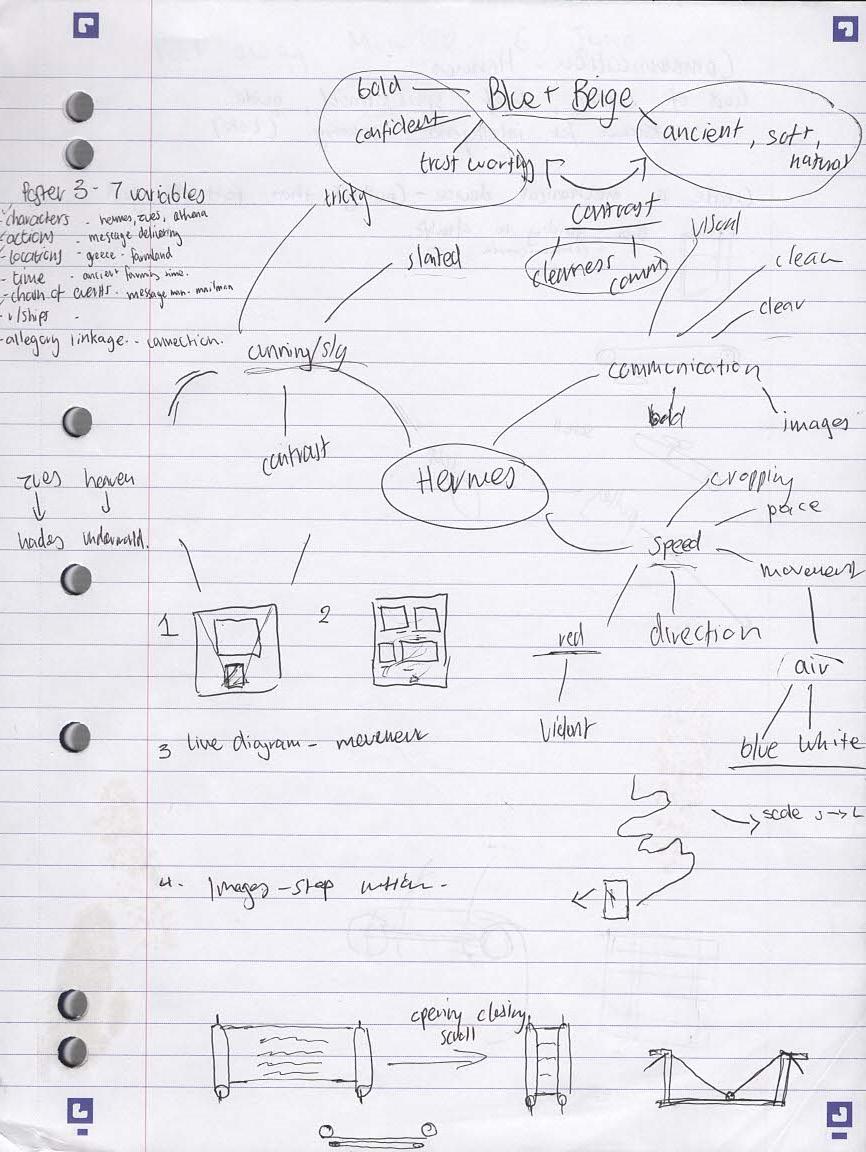


Looking at pulleys (muscle), I originally thought up of a wheel pulley system, with the circle suspended in the air to lift an object up. This was made on a simple parallel railway of which the object could be pulled vertically or horizontally.
Exploration of the meaning behind the character, its relationships, as well as creative influences. Hermes was depicted as fast and agile, along with being cunning and intelligent.

The first idea was looking at the automatic garage door mechanism. This would in tale a door being lifted and a message being shown on the other side

I prompted the idea of a mechanical scroll through the AI imagery creator. I followed more with the lifted scroll design as it can be more readable
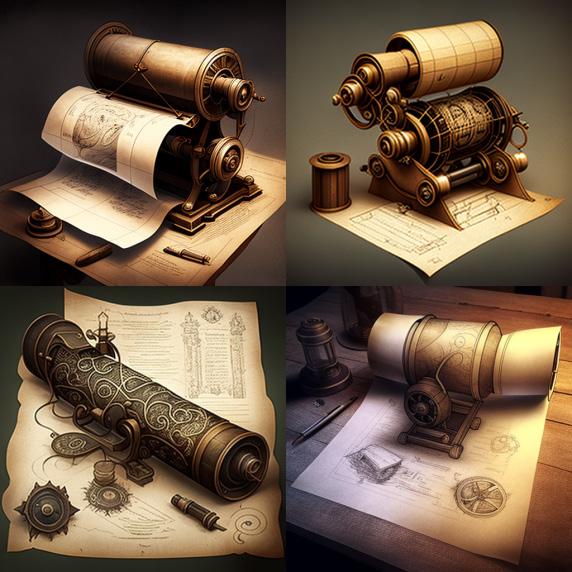
The next idea was an ancient scroll, used as a device to communicate. This idea inspired a mechanism that would open and close the scroll on a wire/ rope device.
The scroll better represents the idea of communication as it would have been used in those ancient times.
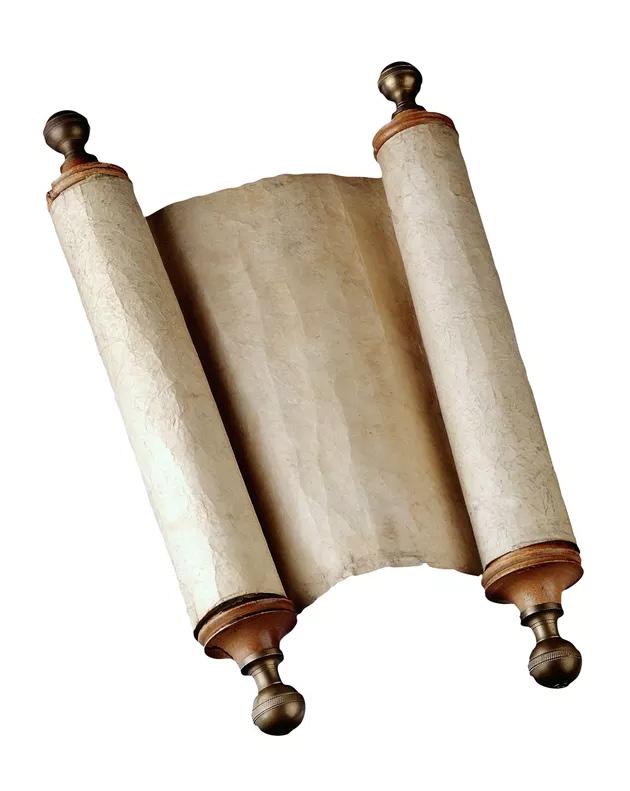

How can architecture communicate emotively with its occupants?
Architecture is emotive, it can communicate with its occupants, and can interact with the occupants in creative and technical ways. Interaction with the occupant can occur through different materials and construction methods. For example; The Bund Finance Centre –Shanghai China by Heatherwick studios project the idea of emotion through the movement of the bamboo like exterior constantly wrapping itself around the façade. The constant movement of the bamboo represents the busy lifestyles of those who occupy the area and their inability to slow down.
Alternatively, The People’s Committee Building in Ho Chi Minh City (Vietnam) communicates the notion of wealth and power by its domineering presence. This is due to the historical significance of the area and the colonial history that the French provided in the take over of the land. The People’s Building Committee features strong vertical elements of pillars and spires which demonstrate a connection to colonisers mother country. Furthermore, the symmetry of the building impedes onto the street and passer bys communicating a sense of fear.
As a creator, it may appear obvious how your idea transformed into the design. For a viewer, this may not be a case.
How can designers make sure their design communicates the idea accurately?
Designers create a process in the form of a journal to track movements and decision making in design. In this journal, it dictates a sense of direction, with labels and call outs explaining why a process did not work, or alternatively did. This shows development accurately, and is easily accessible to; a) the designer, b) the client, and c) future reflections. This creative process enables the designer to developer stronger concepts, and be able to reflect upon their work.
How can designers make sure their visualizations and representations of the design communicates the idea accurately?
Designers can evaluate drawings or ideas via textural elements and design principles. Highlighted ideas, worded evaluations, and textured linework, are some examples of representing ideas effectively. More so, following the rules and principles of art and design, creates a base knowledge for the viewer to perceive things and thinking. This means that, for example, a piece of work follows the ideas of cropping and repetition, can be easily distinguishable, and highlight-able. This, in turn, allows the reader to more easily grasp the idea in one, two, and three dimensional form.
Following previous experimentations, the scroll would be framed so that verticality movement could occur. The design ideas allowed for a piece of parchment to move down via a stepper motor, than traverse upwards to retract, creating movement.



To the left, is an example of expressive architecture, as a guide for my studies. This idea revolves around a sphere opening and closing via elbow like joints to change the internal space and purpose. This idea caught my eye as to the versatility of the space, as well as the importance of the expressive geometry and linework provided.


These ideas and illustrations by other designers give an insight into what interactive architecture could be, and break the boundary of static construction.
This was the aim for my installation as for the purpose to not be static like the built form.
Therefore, I expressed the idea of adjusting the heights, or z coordinates, to give more depth to the installation. This, in-turn, created more complexities as to add a pulley system to the roof of the given location. More so, how would the pulley be powered? Is it powered? How do they move?
All things needed to be considered.



Refining the scroll framework was for the site of the AMDC Building voided space. This allows adequate vacancy, as well as movement opportunities between multiple floors. Students and viewers could gaze across voided areas to inspect text of images printed on the scrolls whilst they moved up and down, counter weighting each other, and moving within the frame.
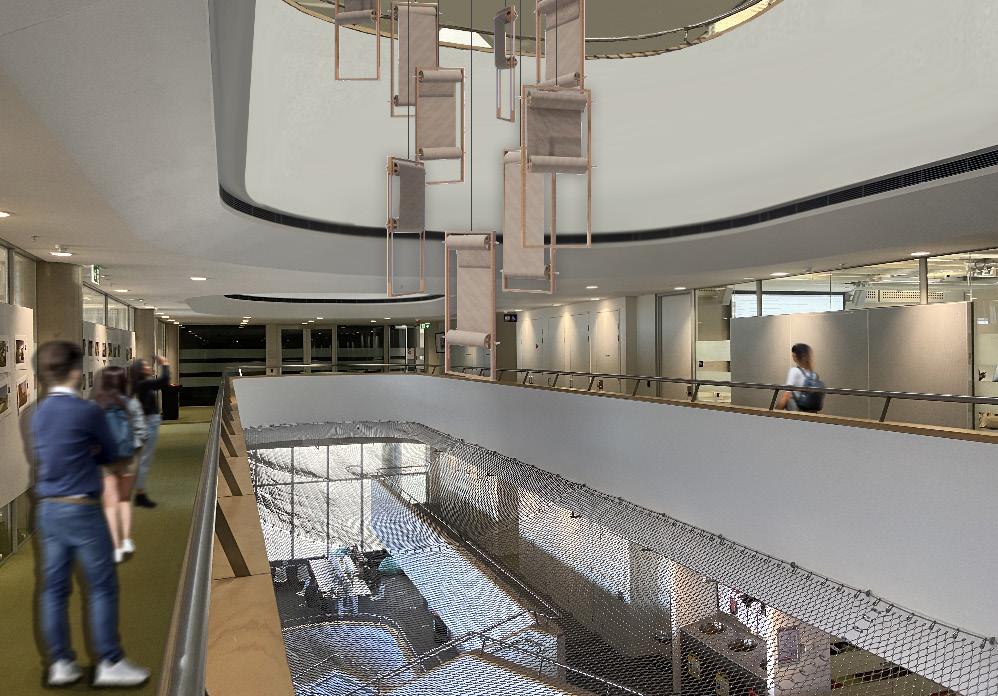
As Hermes is the Messenger of the Gods, he needs to be represented in forms of communications.
Mailbox
Opening and closing of a hinged door on a mailbox conveying a message transfer.
Castle door
Following the combination of the mailbox and door- creates a drawbridge mechanism.
Doorway
The most basic form of communication, a door way. Also acting on a hinge.
Bell
A reception bell which is compressed to trigger a noise. Transfer of energy into noise creates communication.
Letter
The letter acts upon the hinge of the doorway, but with the addition of the bell as for a notification or ding noise received via email.
Scroll
The combination of both the time period of draw bridges uses as well as the form of a letter.
The scroll controlled within the frame will move upwards via a stepper motor, and down via gravity. This is due to the axles of the scroll being controlled within the geometry of the frame.
Hermes controls the movement of communication, from the overworld to the underworld, and therefore the scroll follows the same vertical movement as of which Hermes travels.


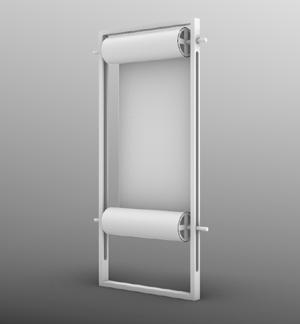
Design varieties may help customise the design to specific site-specific needs. However, what are the impacts of design variations on fabrication processes?
Design variations are adaptations of a similar product. To find the best suited design for an environment requires different thinking, and trying unique variations of the work. This, in turn, creates unique variations that are specifically designed for the location and/or environment. These different designs can cause the production process to be altered as to create unique parts or connections to the environment to specifically cater for the installation. For example, a simple metal plate join with bolts connecting to a wooden slab, or beam, may only need pre-drilled holes, bolts and nuts to hold the metal plate in place. Whereas, if the installation was to be joined onto a complex join, in a high corner of a space, may require a different approach of through bolts and a support column- which could create additional costs, more work, and unique production processes.

By now, you should have attempted to use Gansterer’s Key Lines on analysing and interpreting your design (refer to last and this week’s activity). What else can line drawings do, apart from representing a design?
Linework can effectively communicate the ideas behind two dimensional drawings. By having textured, different gradient lines, an idea can be more communicative and easier to read. Lines give form, and without form, no visualization can occur.
An architectural experience is more than just the design itself. It is also the atmosphere of the space. Aside from the design, what other elements in an architectural representation can architects use to communicate experience?
An architectural experience should also aim to tell a story. By guiding a person’s journey through the space, an experience can be created with a meaning that may be on a deeper level. This could mean connecting to an emotion element, or by hypnotizing someone through a maze of story to reach an end destination.
The First prototype was a piece of paper (combining muscle and skin together.
This model failed to following expand the paper as due to not enough tension. Peer review also suggested adding the paper in, as to incorporate skin into the design.
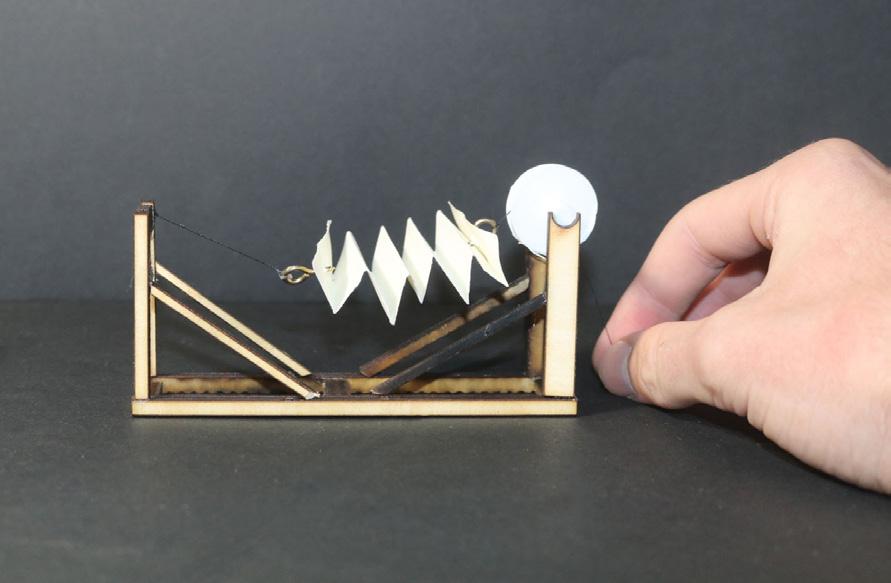
The second development was the piece of communication (scroll) to be placed within a frame. As shown on left. This created a downdraft of motion as the scroll would be released and dropped to reveal an image or idea.
This was represented via the air flowing around the frame.


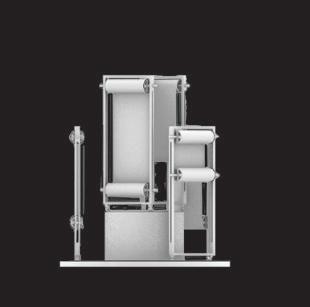







aimed

The angled ceiling frame was exploring the use of ceilings to create interesting geometry as well as displaying downwards, forcing viewers to look up and examine in detail.
Multiple miniature frames hung from the ceiling aimed to counterweight one another as they glided upwards and downwards with motion, creating verticality in a vertical space

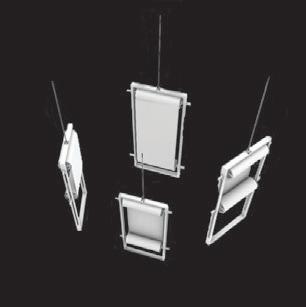
The circular pedestal was created with the intention of the viewers being able to directly interact with the installation, 3600 access.
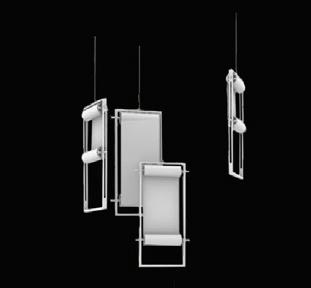
The Story:
The story of Hermes and Persephone involves two of the most wellknown figures in Greek mythology.
Persephone was the daughter of Demeter, the goddess of agriculture, and Zeus, the king of the gods. She was known for her beauty and was often sought after by many suitors. However, one day while she was gathering flowers in a meadow, she was abducted by Hades, the god of the underworld, who fell in love with her at first sight.
Demeter was devastated by the loss of her daughter and searched for her everywhere, neglecting her duties as the goddess of agriculture and causing famine and drought across the land. Eventually, she learned that Hades had taken Persephone and went to Zeus for help.
Zeus, who had allowed the abduction to take place, brokered a deal between Hades and Demeter. Persephone would spend half of the year with Hades in the underworld as his queen, and the other half of the year with her mother on earth. This became the explanation for the changing of the seasons, as Demeter mourned the loss of her daughter in the winter months, and celebrated her return in the spring.





Hermes, the messenger god, played a significant role in this story as well. He was tasked with guiding Persephone to and from the underworld each year, acting as a mediator between her and Hades. While there are variations of this story in different versions of Greek mythology, the basic premise remains the same - the abduction of Persephone, her time spent in the underworld, and her eventual return to her mother on earth.

For the final model design, I used AI generated images to involve into the skin of the machine. These pictures were aimed to depict a story of Ancient Greek characters and myths that would pop out when the scroll was opened, revealing themselves. The scroll would need to flex, and roll back into self, so the popups needed to have folded springs behind to give the ability to jump out.


The first design was a stand-a-lone fork, with a pulley wheel system placed on top, that would act as the muscle of the machine. This pulley would be anchored to another pulley wheel, (a design iteration later added to the final) to create a dynamic scroll system.
However, I found this idea complicated, as it would add another dimension to the machine that would need to be fine tuned so that the scroll could still open successfully.

Therefore, the design I ended up going with was the stable, frame set-up, that allowed the scroll to open and close through a track made in the hypotenuse like beams. This design still needs more refining, but overall portraits the concept of what the machine does.
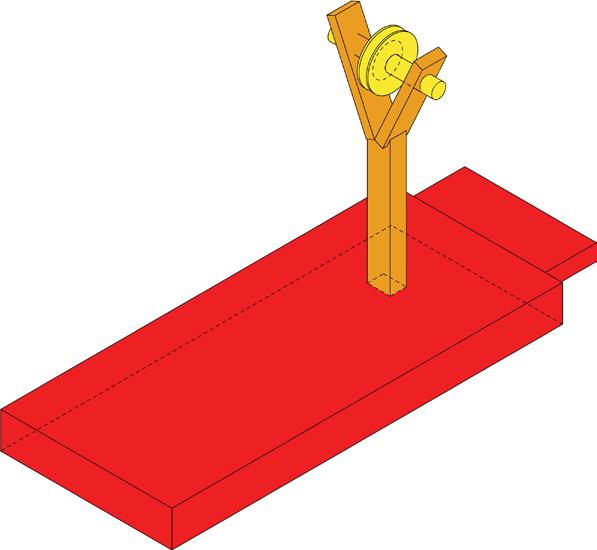
Scroll will be able to move as counterweights for one another, meaning that in the mezzanine space, scrolls and frames will be extending and retracting constantly which creates a connection with the viewer.
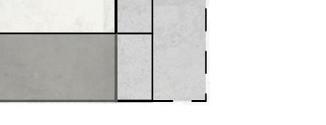
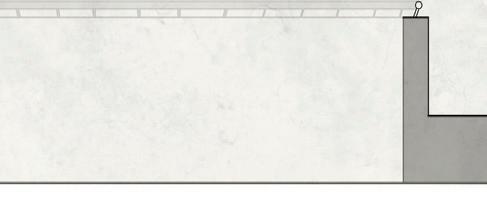


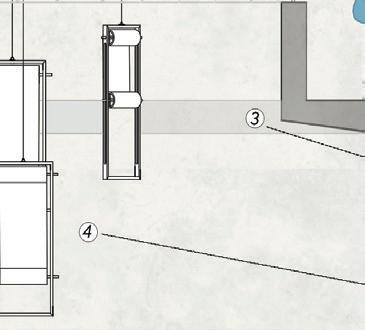
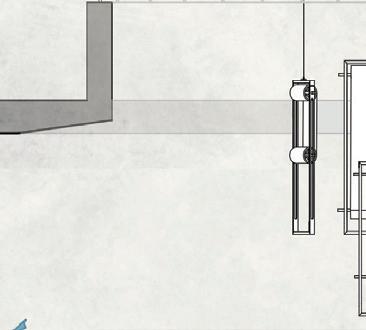
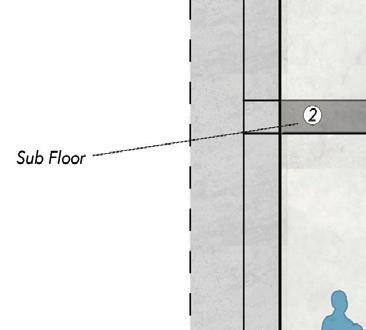





I peer reviewed poster iterations to understand how best to communicate Hermes’ allegory in a visual form. I chose the story of Persephone as it best described a; Hermes’s role, and b; the characters and significance of the mythology map, as it spanned many characters, places, and ideas.
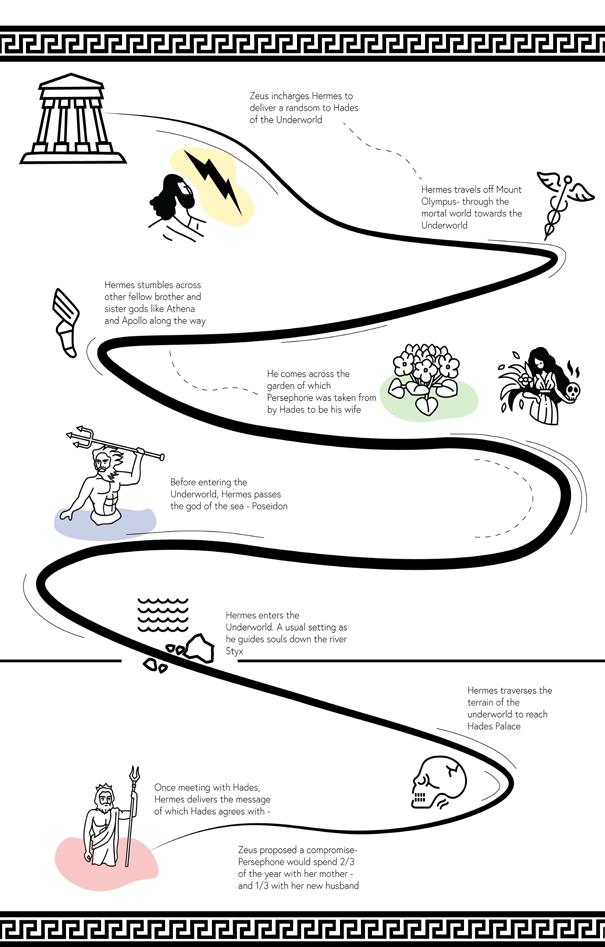
I liked the curve of the first poster, as it showed a clear line from start to finish in a reading order, as well as giving depth and flow.
As seen in the final poster, the idea for the line stayed. However, symbolism was used to represent characters and locations, whilst staying simplistic and minimal.
I also feel as though there might be too much white space, as to make a bland poster that would not grab attention, however I added a gradient background that overpowered the poster, so I decided against.
Alterations of the poster was aided by feedback regarding text hierarchy, as well as readability. I decided with the idea of creating alternating pages of colour, creating pattern and unison.


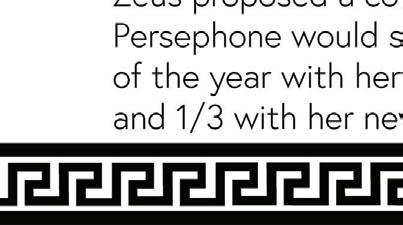

























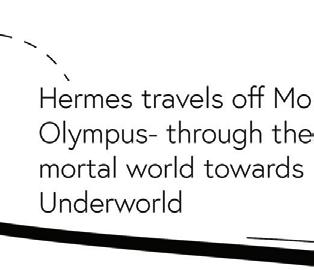
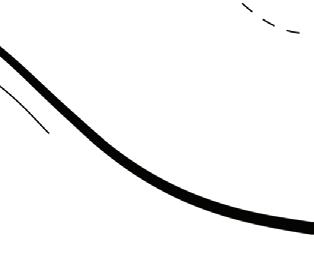







What is the ‘art’ that your design is performing, and how did you explicitly represent this in your posters?
Architecture can be represented as art. In my case, the communication of the scroll moving in its environment, both via the scroll going up and down, as well as the framework counterweighting each other creates a fluid motion which can be perceived as art. The idea behind this motion was to gather the viewers attention by the movement of the frame, and then communicate the idea of visual images and languages imprinted onto the scroll. This is similar to the motion of a modern advertising board, but would feature students creative works due to the environment the installation is in.
What challenges did you face in representing this ‘art’ on your posters?
The artwork can become extremely 2 dimensional. This means that due to the visual language projected onto paper, the story/ meaning can only be seen from one side. This creates a sense of disconnection as the viewer isn’t able to directly interact, touch or feel the installation. Hence, why the movement of the frames was added, to create more depth to the installation and allow the eye to follow the movement.
What is the ‘technology’ that your design is using to perform, and how did you explicitly represent this in your posters?
The technology implemented into the design of my installation are based of the motion of skin (paper) and muscle (pulley system). This is not new technology and has been globalised a long time ago. However, the dynamic combination of the two elements create an interesting installation.
On top of that, would be the use of a stepper motor. This will be automated to move the scrolls (paper) up and down in a slow motion. All were labeled in the connection to environment via linework.
What challenges did you face in representing this ‘technology’ on your posters?
The challenges discovered were via the communicate of linework and shapes. The idea is easy to imagine, but difficult to communicate via drawings and sketches. Repetition is the tactic employed to navigate the ideas of technology, as progressively through the posters features similar shapes of papers, and the reoccurring theme of a pulley system.
Why is important to structure how you visually and verbally communicate your design in your presentations? `
Design principles are incredibly important as it aids to communicate your ideas and thoughts. Using clean lines and a grid system- along with hierarchy, assists the viewer into reading the visual language and dialogue. Having titles that match in with text boxes, both in terms of font, but as well as alignment, helps the reader follow the structure and direct the eye to important, key features.
On top of that, like in Poster 3, the continuous linework that ripples down like a river, guides the viewer through the text to tell the story. This can only be accomplished by a singular line.

To conclude: I feel as though if more time was added to the design, it could have been something quite well made. The concept was there and the characters did create the ability to explore design principles and concept correctly and with impact as well.
However, in saying that, the model could be more expressive and not so lateral, made of different materials and be more flamboyant. I liked the aspect of exploring both AI’s and incorporating the drawings and details into the project was exciting and refreshing.

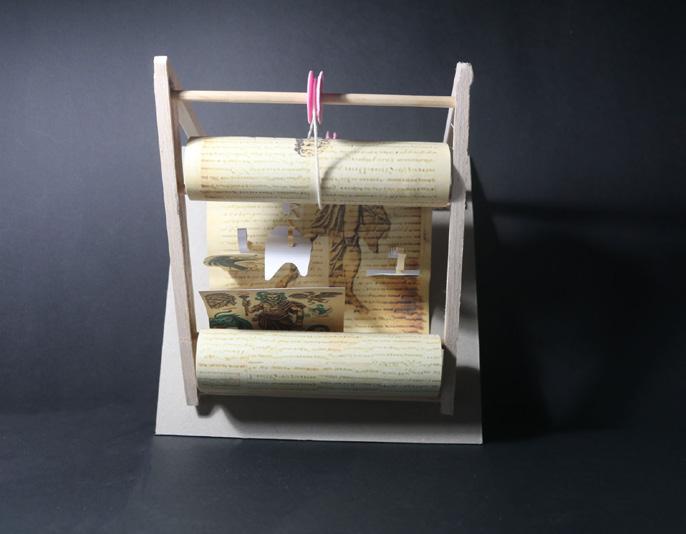
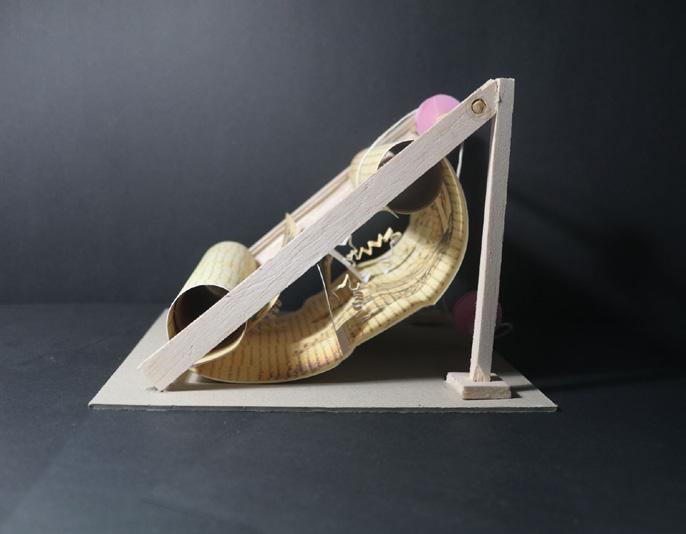





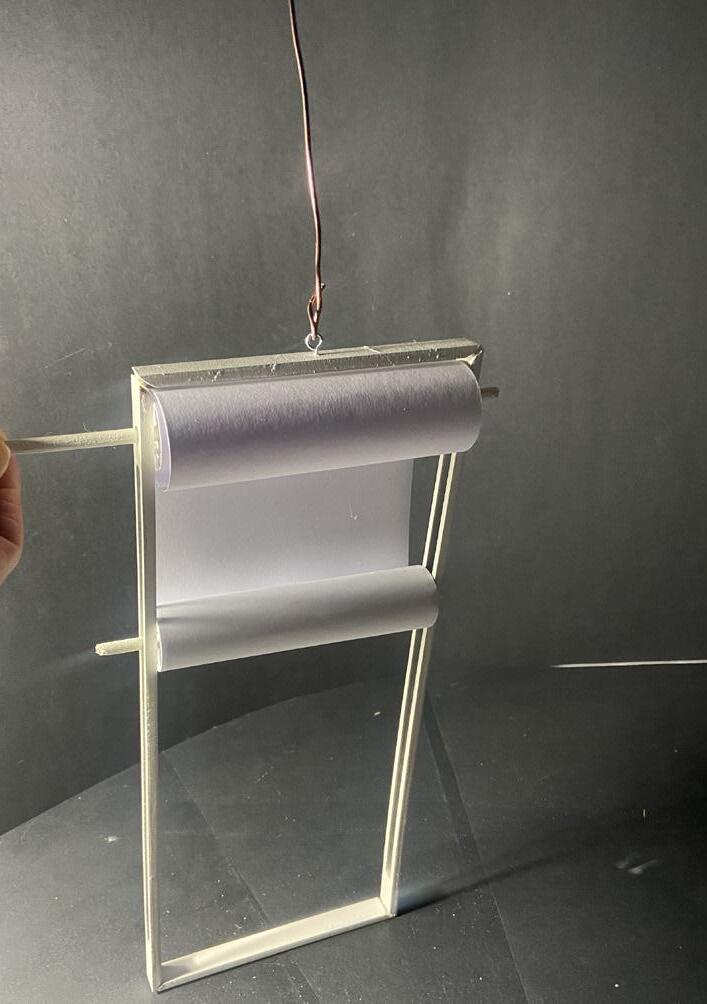



Why is important to structure how you textually describe your design process in folios?
Structuring text is just as important as structuring verbal language. Text needs to be fluent and easy to read. Again, this will aid the viewer into reading the material correctly, as well as assist the viewer into understanding the visual text. A coherent grid structure aims to set up the page correctly and offers a unified layout.
Did you, and if so how, consciously structure your design communications in previous projects?
Consciously in the past, poster layouts would follow a similar pattern of communicating an idea from start to finish. However, with the content of this class, projects have had a deeper meaning due to design techniques like linework and visual hierarchy. I thought more about the purpose of placing an image on the page, compared to previously, anchoring the image and building around.
Will you, and if so how, consciously structure your design communications in future projects?
Structuring design posters, or anything, like ideas- need to be communicated. The easier an idea is to read, the easier the idea is to communicate. Structure is the second most important element when it comes to being creative, second only to the idea. An idea can be amazing, but if the designer is unable to communicate that idea thoroughly, and conceptually, they may fail in their task.
In turn, conveying an idea effectively comes down to the communication of the product. An idea alone cannot sell an entire idea, it needs to be backed correctly without thought and processes.




See figures:
Figure 1
Figure 2
Figure 3
Figure 4
Figure 5
Figure 6
Figure 7
Figure 8
Figure 9
Figure 10
Figure 11
Figure 12
Figure 13
Figure 14
Figure 15
Figure 16
4
5
7
7
7
8
10
10
12
14
14
14
14
17
17
17
Text cited -
Zelazko, A. (no date) Hermes, Encyclopædia Britannica. Encyclopædia Britannica, inc. Available at: https://www.britannica.com/topic/HermesGreek-mythology (Accessed: March 15, 2023).
+Greekacom (no date) Persephone, queen of the underworld - greek myths: Greeka, Greekacom. +greekacom. Available at: https://www. greeka.com/greece-myths/persephone/ (Accessed: March 15, 2023).
Astma, A.J. (2017) K14.9 Persephone & Hermes, Persephone & Hermes - Ancient Greek Vase Painting. Available at: https://www.theoi. com/Gallery/K14.9.html (Accessed: March 15, 2023).
Mackie, C. (2023) Explainer: The story of Demeter and persephone, The Conversation. Available at: https://theconversation.com/explainer-thestory-of-demeter-and-persephone-110898 (Accessed: March 15, 2023).
Photo references
Staff of Hermes Caduceus as a symbol of medicine rod of asclepius, doctor, text, people, Logo PNG PNGWing. Available at: https://www.pngwing.com/en/free-png-yshzg (Accessed: March 15, 2023).
Ninidu Hermes doodles by Ninidu on DeviantArt, by Ninidu on DeviantArt. Available at: https://www.deviantart.com/ninidu/art/Hermes-doodles-441475238 (Accessed: March 15, 2023).
Leadbetter, A. (2016) Hermes, Battlestar Olympia | Obsidian Portal. Available at: https:// battlestarolympia.obsidianportal.com/wikis/hermes (Accessed: March 15, 2023).
CDNA (2018) Pin on gods and goddesses, Pinterest. Available at: https://www.pinterest. com.au/pin/226657793733082968/ (Accessed: March 15, 2023).
Joao (2022) Pin on mythology, folklore and other epic stories, Pinterest. Available at: https:// www.pinterest.com.au/pin/174444185557922060/ (Accessed: March 15, 2023).
Pin on illustration and drawing (2022) Pinterest. Available at: https://www.pinterest.com.au/ pin/273241902383506405/ (Accessed: March 15, 2023).
Yliade (2019) Hermes ~ Greek mythology by Yliade on DeviantArt, by Yliade on DeviantArt. Available at: https://www.deviantart.com/yliade/art/Hermes-Greek-Mythology-817434906 (Accessed: March 15, 2023).
Szac, M. (2017) The adventures of hermes, god of thieves: 100 journeys through greek mythology (paperback), Hooked. Available at: https://www.hookedlansing.com/ book/9781782691303 (Accessed: March 15, 2023).
Hermes Hermès bust Greek mythology sculpture, Greek god, stone carving, arm, Boston PNG PNGWing. Available at: https://www.pngwing.com/en/free-png-cjizs (Accessed: March 15, 2023).
Hermes (2023) Google search. Google. Available at: https://www. google.com/ search?q=hermes%2Bmythology&rlz=1C5CHFA_
Parkjisun, Parkjisun, Noun Project. Available at: https://thenounproject.com/naripuru/ (Accessed: March 20,